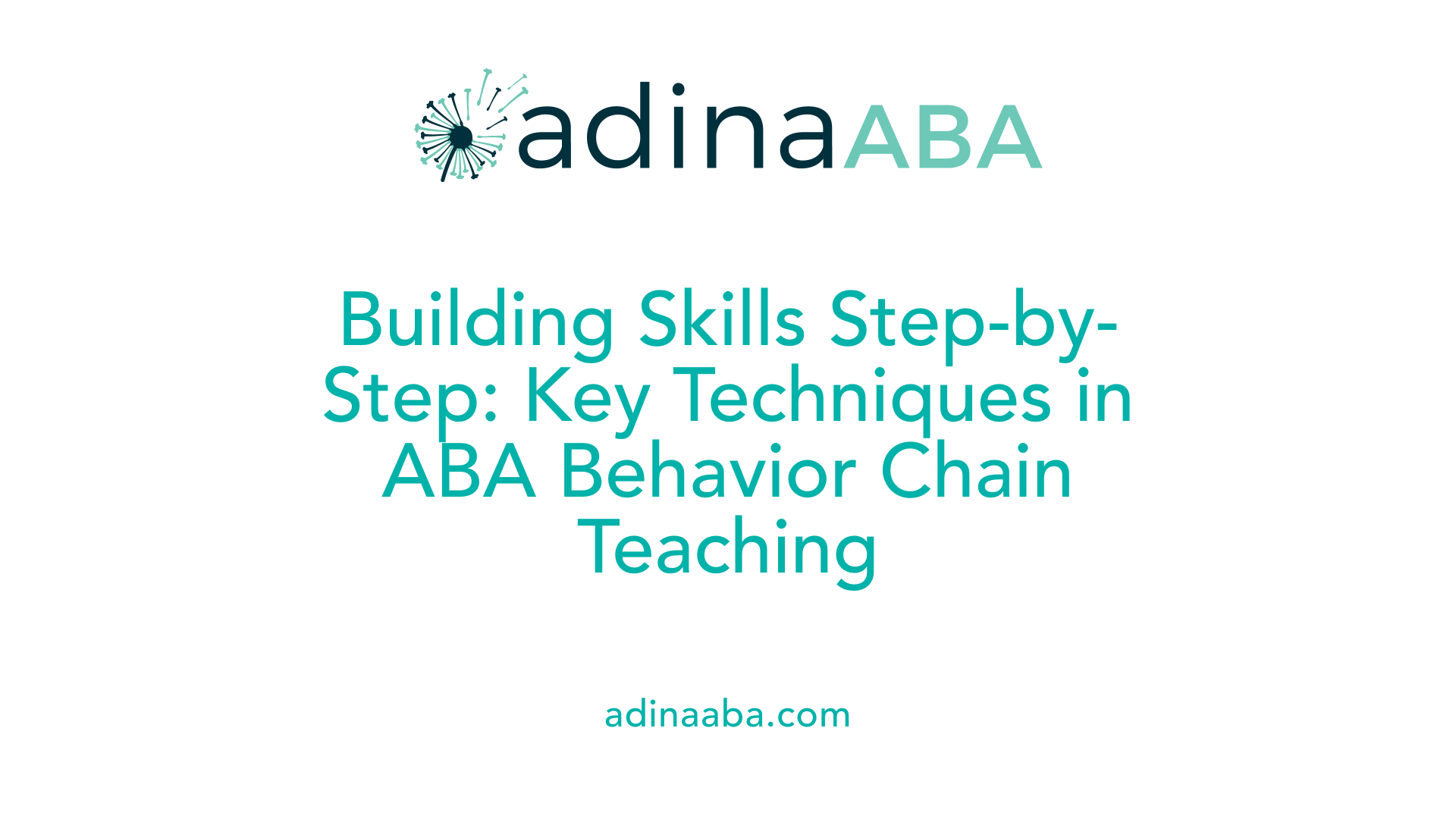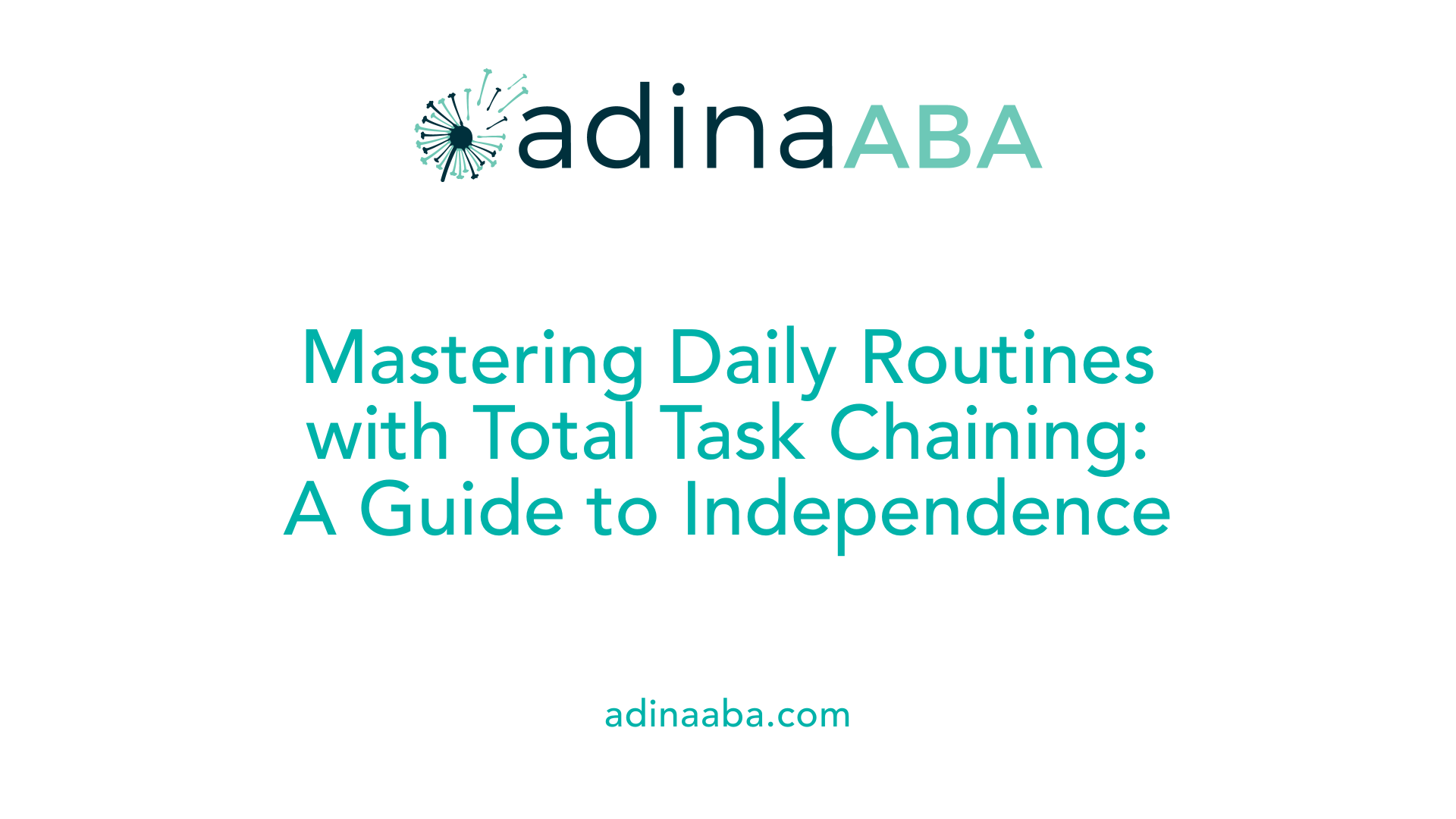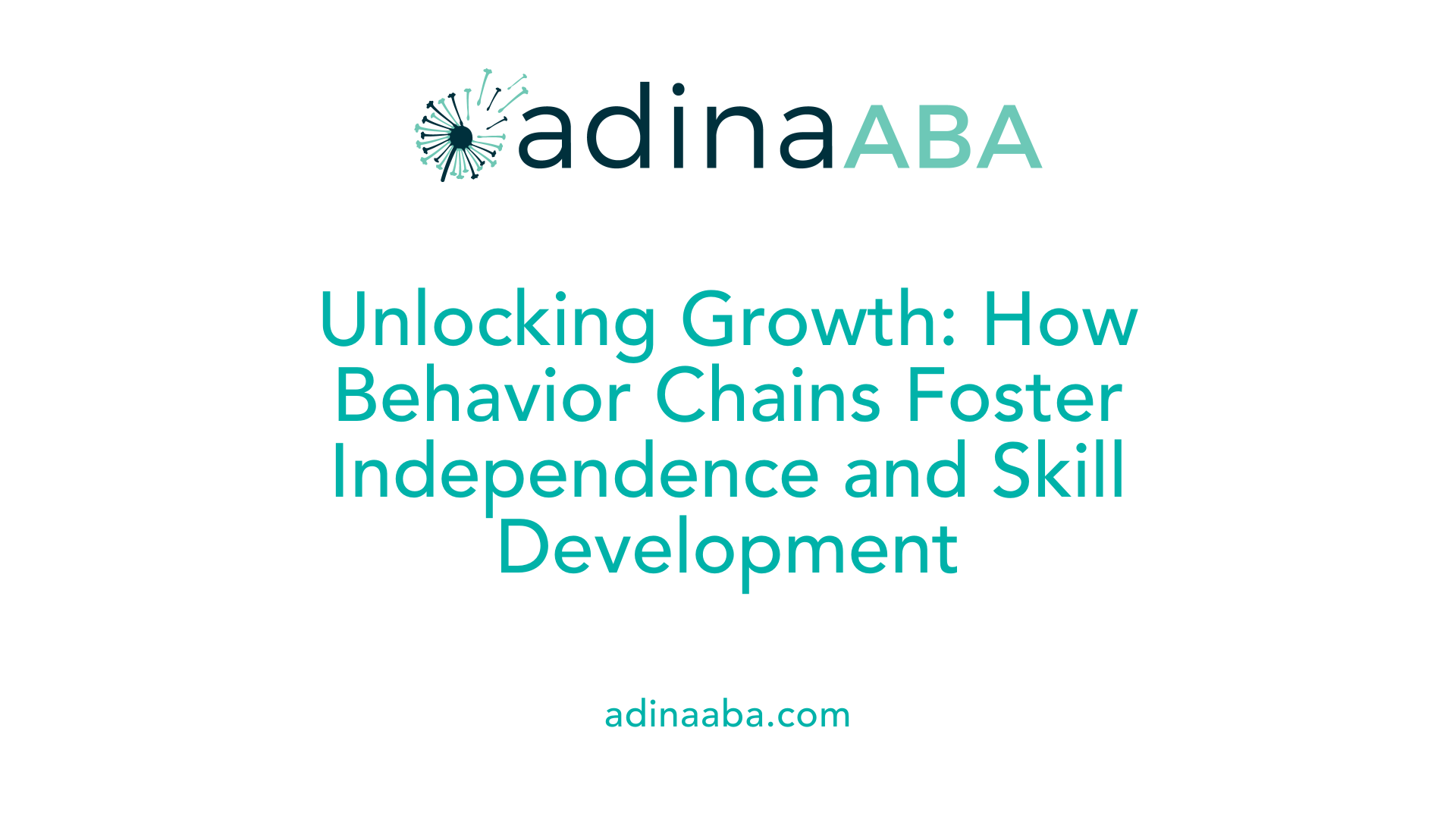What are behavior chains in ABA

Understanding Behavior Chains in Applied Behavior Analysis (ABA)
Behavior chains are a cornerstone of ABA therapy, serving as an evidence-based method to teach complex, multi-step skills by breaking them down into manageable parts. This approach facilitates skill development, independence, and behavior modification, especially in individuals with autism. In this article, we explore what behavior chains are, how they work, the techniques used to teach them, and their vital role in behavioral development and therapy.
What Are Behavior Chains in ABA and How Do They Work?
What are behavior chains in ABA and how do they work?
Behavior chains in ABA are sequences of individual behaviors that are linked together to form a complex, functional skill. Each step within the chain acts as a cue or prompt for the next response, creating a tightly connected sequence that ultimately results in a specific goal, such as brushing teeth or making a bed.
These chains are built through a process called task analysis, where a complex skill is broken down into smaller, manageable steps. This breakdown makes it easier for individuals to learn each part of the sequence systematically. At each step, reinforcement is provided to encourage correct performance, helping the individual reliably perform the entire sequence over time.
There are various methods for teaching behavior chains, including forward chaining, backward chaining, and total task presentation. Forward chaining begins with teaching the first step and gradually adds subsequent steps. Backward chaining starts from the last step, working backward to the first. Total task presentation involves guiding the individual through all steps with prompts, gradually fading assistance as they become more proficient.
In natural settings, behavior chains occur as part of daily routines but are also intentionally formed in ABA therapy to help individuals acquire new skills or alter problematic behaviors. By breaking complex tasks into small parts and reinforcing each one, behavior chains promote independence and enable mastery of skills that might seem challenging when attempted all at once.
Overall, behavior chains are a foundational strategy in ABA that support learning and behavioral development by constructing a sequence of responses that lead to the execution of functional, goal-oriented behaviors.
Using Behavior Chains in ABA Therapy for Skill Development

How are behavior chains used in ABA therapy for skill development?
Behavior chains are essential tools in ABA therapy that help individuals learn complex skills by breaking them down into smaller, manageable parts. This approach, called task analysis, involves identifying each step needed to complete a task, such as brushing teeth or dressing.
Different methods of chaining—forward chaining, backward chaining, and total task chaining—are chosen based on the individual's learning style and the skill's complexity. In forward chaining, teaching begins with the first step, and each subsequent step is added as the learner masters the previous one. Backward chaining starts with the last step, ensuring the individual gets reinforced at the completion of the entire task, boosting motivation. Total task chaining involves guiding the learner through all steps at once, with prompts and reinforcement.
These strategies involve specific sequences of instruction and reinforcement, systematically teaching skills in a way that builds independence. Reinforcement plays a crucial role in motivating learners and consolidating each step of the chain. As they progress through the steps, learners gain confidence and mastery over important daily activities.
In practice, behavior chains are used to teach a range of skills, from self-help routines like handwashing and brushing teeth to more complex academic and vocational tasks. The structured nature of chaining helps ensure that individuals gain these skills effectively and retain them over time, making it a foundational technique in ABA therapy, especially for children with autism.
Types of Behavior Chaining Techniques in ABA
What are different types of behavior chaining techniques used in ABA?
In ABA therapy, understanding the various ways to teach complex skills is essential. The three main methods are forward chaining, backward chaining, and total task chaining. Each technique offers unique advantages and is suited to different learning scenarios.
Forward chaining involves teaching the first step of a task first. Once the individual successfully completes this initial step, the next step is taught, and so on, progressing sequentially through the task. This approach aligns with the natural order of many daily activities, making it intuitive for learners.
Backward chaining starts with the last step of the task. The individual learns to complete this final step first, which is then reinforced. Afterwards, the instruction focuses on the previous step, working backward through the sequence. This method ensures the learner experiences a sense of completion sooner, increasing motivation.
Total task chaining is more comprehensive. It involves teaching all steps of a behavior chain at once, guiding the individual through the entire sequence during each session. Prompts are provided as needed, with support gradually faded to promote independent performance.
Each of these methods relies heavily on task analysis, which breaks down complex behaviors into manageable parts, laying the foundation for effective teaching. The choice of technique depends on the learner’s needs, the nature of the task, and intervention goals.
| Method | Teaching Sequence | Reinforcement Focus | Suitable For | Additional Notes |
|---|---|---|---|---|
| Forward Chaining | Starts from the first step | Reinforces each step as it's learned | Beginners, tasks with clear natural order | Builds confidence starting from initial steps |
| Backward Chaining | Starts from the last step | Reinforces the final step before others | Tasks where motivation to reach the goal is key | Ensures the individual experiences success early |
| Total Task Chaining | All steps simultaneously | Promotes independence through practice | When the task is age or ability-appropriate | Requires more prompting during learning, then fading support |
By choosing the appropriate chaining method, ABA therapists can tailor teaching strategies to maximize skill acquisition, independence, and motivation for each individual.
Understanding Total Task Chaining in ABA

What is total task chaining in ABA?
Total task chaining is an instructional method used in applied behavior analysis to teach complex tasks by involving all the steps of a behavior chain within each teaching session. In this approach, the individual practices every step of the task during every session, receiving prompts and assistance as needed. Reinforcement is provided once the entire sequence is completed successfully.
This method begins with a comprehensive task analysis, breaking down a complex skill into smaller, manageable steps. Instead of teaching one step at a time, the teacher guides the learner through the entire activity, prompting and supporting each step as necessary. Over time, prompts are gradually faded, encouraging the learner to complete the entire task independently.
Total task chaining promotes the ability to perform the whole sequence, fostering independence and ensuring skills are more likely to generalize across settings. It is especially useful for teaching daily routines and other multi-step behaviors important for daily living, particularly for children with autism.
How it is implemented
Implementing total task chaining involves a few core steps:
- Identify the skill: Choose the complex behavior or routine to be taught.
- Conduct a task analysis: Break the activity into smaller, sequential steps.
- Teach with prompts: Guide the individual through all steps during each session, providing prompts as needed.
- Reinforce: Reward successful completion of the entire task.
- Fading prompts: Gradually remove prompts so the learner can perform the task independently.
This method ensures that the child is exposed to every part of the task repeatedly, building confidence and skill mastery at each stage.
Examples in daily routines
Total task chaining can be applied to numerous daily routines, such as:
| Routine | Steps Included | Description |
|---|---|---|
| Brushing teeth | Picking up toothbrush, applying toothpaste, brushing, rinsing, putting away | Learner practices entire sequence in each session, with prompts as needed. |
| Making a bed | Clearing the bed, spreading the sheets, arranging pillows, fluffing blankets | Each component taught simultaneously, encouraging independence. |
| Preparing a simple snack | Getting ingredients, assembling, eating, cleaning up | Complete task training helps develop self-care skills. |
Total task chaining simplifies learning these functional skills, especially for individuals needing comprehensive support, allowing them to perform important daily activities with less assistance over time.
The Significance of Behavior Chains in Behavioral and Developmental Contexts

How does chaining contribute to behavioral development and therapy?
Chaining is a cornerstone technique in Applied Behavior Analysis (ABA) therapy that plays a vital role in fostering behavioral growth. It works by breaking down complex actions into smaller steps through a process called task analysis. This enables individuals, particularly those with autism or other developmental challenges, to learn multi-step behaviors such as handwashing, brushing teeth, or making a bed.
In therapy sessions, different types of chaining—forward, backward, and total task chaining—are used based on the individual's specific needs and the complexity of the skill. Forward chaining teaches the first step first, then gradually adds subsequent steps, ensuring a natural progression. Backward chaining begins with the last step, reinforcing completion from the end to the beginning, which often provides immediate success and motivation. Total task chaining involves guiding the individual through all steps at once, promoting independence.
This structured approach helps individuals develop independence by teaching them how to perform daily tasks without assistance. It also reduces anxiety often associated with complex behaviors by providing clear cues and reinforcing successful completion of each step. By making learning more engaging and systematic, chaining encourages skill mastery, promotes confidence, and supports a wide range of developmental and behavioral goals.
Misconceptions and Scientific Insights into Behavior Chains in ABA

What are some common misconceptions about behavior chains in ABA?
A prevalent misunderstanding about behavior chains in ABA is that they are only suited for simple tasks or exclusively used with children with autism. In reality, behavior chains are versatile teaching tools applicable to a broad spectrum of skills and individuals of all ages. They play a vital role in teaching daily routines like handwashing, grooming, or making beds, as well as more complex activities such as vocational tasks.
Additionally, there is a misconception that ABA therapy's primary goal is to "cure" autism or to make children behave like neurotypical peers. Actually, ABA focuses on supporting skill development, fostering independence, and helping individuals navigate their environment successfully. It emphasizes positive reinforcement and functional behavior change rather than punishment or rote drills.
Another widespread myth is that ABA is solely about strict training or punishing wrong behaviors. Modern ABA practices prioritize individualized programs tailored to each person's needs, emphasizing positive reinforcement, meaningful goals, and reducing maladaptive behaviors through understanding and support.
Many also believe that ABA can only be effective with young children. Yet, it is successfully employed across all age groups, including adolescents and adults, to develop life skills, vocational abilities, and adaptive behaviors.
These misconceptions often originate from misunderstandings of the scientific principles behind ABA and its person-centered, evidence-based approach, which values respect, personalization, and fostering long-term independence.
Versatility of behavior chains
Behavior chains are integral in teaching complex skills by breaking them down into manageable steps, following a process called task analysis. Whether it’s brushing teeth, dressing, or following a daily schedule, chains connect individual responses in a sequence that results in a final goal.
Various chaining techniques—forward, backward, and total task presentation—allow therapists to adapt teaching based on the learner’s needs and the skill's complexity. For example, backward chaining is often effective for teaching tasks where completing the final step first can motivate ongoing participation.
This adaptability shows how behavior chains are not limited to autism or simple behaviors—they are sophisticated, flexible tools supporting multiple developmental and behavioral objectives.
Effectiveness in diverse populations
Research demonstrates that behavior chains are influential across a variety of populations and settings. For instance, studies show that around 68.7% of individuals at a low adaptive level achieved significant improvements within 24 months of ABA therapy, illustrating their broad applicability.
Moreover, ABA strategies, including chaining, have been effective in helping individuals learn vocational skills, daily living activities, and communication, promoting greater independence.
Because behavior chains are rooted in scientific principles like stimulus-response associations and reinforcement, they provide a reliable method for skill acquisition across different ages, abilities, and contexts.
| Aspect | Details | Additional Insights |
|---|---|---|
| Typical Applications | Daily routines, vocational skills, social interactions | Used for teaching functional, adaptive behaviors |
| Techniques | Forward, backward, total task | Chosen based on individual needs and task complexity |
| Population | Children, adolescents, adults | Effective for various developmental and behavioral goals |
| Benefits | Increased independence, skill mastery | Supported by research and clinical outcomes |
| Common Misconceptions | Limited to autism, simple behaviors | Dispelled by scientific evidence and practical success |
Understanding the misconceptions about behavior chains enhances appreciation for their scientific foundation and versatile application, underscoring their importance in effective behavioral interventions.
Harnessing Behavior Chains for Effective Learning
Behavior chains in ABA are vital tools that facilitate the teaching of complex skills through structured, sequential teaching techniques. They help individuals, particularly those with autism, build independence across various life areas. By understanding the core concepts of chaining and choosing appropriate methods—whether forward, backward, or total task—therapists and caregivers can tailor interventions that promote skill mastery and functional independence. Dispelling misconceptions and grounding practices in scientific evidence ensures these strategies are used effectively, maximizing positive outcomes and fostering growth for learners of all ages.
References
- What Is “Chaining” And How Is It Used In ABA Therapy? - BlueSprig
- Behavior Chaining - Applied Behavior Analysis Degrees
- Behavior Chaining - Association for Science in Autism Treatment
- Chaining In ABA Therapy | Circle Care Services
- Analysis of Factors That Affect Responding in a Two-Response ...
- What is Chaining in ABA Therapy? | Childwise
- What is The Chaining Technique in ABA Therapy? - Brightside ABA
- What is "Chaining" in Applied Behavior Analysis?
More Resources
Expert Clinicians
Get started today ->


.jpg)



